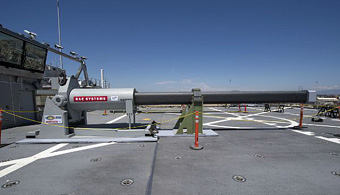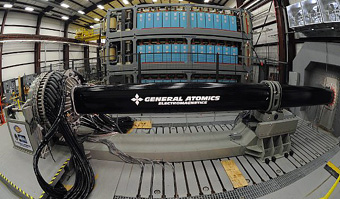
Photos courtesy of U.S. Navy/Department of Defense
The Big Guns of the Future
| published February 17, 2016 |
By Earl Perkins, Thursday Review features editor
The future of warfare, for better or worse, is almost here. Among the new tools of high-tech war are the F35A & B Lightning warplanes—with their stealth capabilities, north-of-Mach 1.6 speed, and an elaborate system of visual tools and software which allows pilots, literally, to see in all directions.
Then there is the USS Zumwalt, a stealth destroyer bristling with high-powered weapons, weird space-age lines and exotic hull, and state-of-the-art computer technology—much of it top secret. The Zumwalt is more than 600 feet long and 80 feet wide, making it the largest destroyer ever built by any navy in any age. And at $3.57 billion, the Zumwalt may be the most expensive warship ever conceived and built.
Both the USS Zumwalt and the way-over-budget F35s—and their complex and controversial layers of software—are what weapons technologists call “next generation” tools of war. The Pentagon eschews words like “ship” and “plane” to describe them, preferring instead to call these systems “weapons platforms,” the brass refers to the F35B as a “5th Generation” aerial fighter.
But there is much more to what the Pentagon hopes to soon have in its tool chest of high-tech weapons. The U.S. Navy has been testing an electromagnetic railgun which could help revolutionize warfare, seeing possible installation in the near future on the Zumwalt-class destroyers, according to the Associated Press and several military journals.
Formerly seen only in video games and science fiction, the state-of-the-art weapon will almost certainly be installed on the USS Lyndon B. Johnson sometime in the next 18 months, said Adm. Pete Fanta, Navy director of surface warfare.
The Navy's plans for the cutting edge-technology are in flux, but land-based tests were so successful that the LBJ scenario could emerge as our nation's best option. The destroyer is tentatively scheduled to be placed in service in 2018, and the hope is that the Lyndon Johnson and the Zumwalt—indeed all in the class—can be easily fitted for the railgun and its powerful potential.
“The Zumwalt-class is one of a number of options being explored for the electromagnetic railgun,” said Lt. Cmdr. Hayley Sims, a Navy spokeswoman. “Due to the size, weight and power requirements, some platforms will be better suited for the technology than others.”
Railguns use electricity instead of gunpowder to accelerate a projectile at six or seven times the speed of sound (5,600 mph), which creates enough kinetic energy to destroy targets. The new technology could save money—hundreds of millions, even billions—on ordnance, because smart bombs, cruise missiles and conventional rockets are extremely expensive.

The railgun will hurl an essentially a dumb bomb—likely a hunk of dense metal and composite material—at mid-boggling speed. Even without explosives or chemicals, a simple solid object travelling at Mach 7 can cause catastrophic damage, and when the system has been effectively coupled with computer-assisted targeting capability, using state-of-the-art GPS modeling, the railgun’s accuracy means a single slug of metal fired at an incoming warplane, a North Korean missile, or a boat piloted by al Qaeda militants…well…game over for the target. At sea, the railgun has the capability to take out an enemy ship within minutes, destroying enemy guns, and punching lethal holes in a ship’s hull.
The USS Lyndon Johnson is the third and final destroyer in the Zumwalt class (Congress shelved the original DoD request for 32 destroyers in the Zumwalt Class), and its power plant dovetails well with the new technology. The 600-foot-long warship utilizes marine turbines similar to those on Boeing 777s, which may produce up to 78 megawatts of electricity to power propulsion, weapons and sensors. The system will probably be placed where a forward gun turret houses a 155mm gun that fires rocket-propelled projectiles.
The present official plan calls for the railgun prototype to be tested aboard a joint high-speed vessel this year, although it could be pushed back another year, and Adm. Pete Fanta—the U.S. Navy’s director of Surface Warfare—has suggested scrapping that plan in favor of placing the first working version directly on board the USS Lyndon Johnson, or possibly the Zumwalt upon its return from sea trials. Fanta says that railguns and laser weaponry are futuristic technologies which have evolved rapidly from scientific research to practical engineering.
Those systems, coupled with smart munitions that improve existing naval guns, are the Navy's future. Low cost and lethality are extremely important in today's volatile world, because budgetary constraints have caused numerous cost-cutting measures throughout all branches of the Armed Forces.
“The Navy is determined to increase the offensive punch of the surface warships,” said Loren Thompson, defense analyst at the Lexington Institute. “To do that with a limited budget, it needs to look at everything from smart munitions to railguns to lasers.”
The technology has been on the drawing boards for decades, but limitations in technology have made any practical development prohibitively expensive. But innovations in cooling and metallurgy, engine and turbine technologies, coupled with the most recent leaps in computer technology, have brought these futuristic guns toward reality very quickly.
Prototype railguns have been constructed and tested numerous times since late 2013, and again throughout 2014. The two largest contractors at work on the project—General Atomics and BAE Systems—have conducted successful shop tests for Pentagon officials. The next step will be testing at sea in real world conditions, followed by getting the per gun cost down to within the projected Pentagon budgets.
There has been little discussion of the new technology at the shipyard in Maine, and representatives of Bath Iron Works, a subsidiary of General Dynamics, were unavailable for comment. Paradoxically, the talk about railguns was more abundant in 2013 and 2014, but chatter has dried up now that the guns are perhaps only months away from being installed on board a Navy ship. Less talk equals more reality, and weapons experts suggest that we may see real world testing very soon.
The “rail” in railguns is actually two rails. The gun itself is basically a giant conductor of electricity—two parallel metal rails along which massive amounts of electrical current is passed, generating a magnetic field in the space between the two conductive rails. Ordnance, basically a dense metal projectile, is loaded in the narrow space between the rails. An armature at the base of the gun acts to first close the circuit between the two opposing rails, and second to expedite a third electrical charge which is repulsed by the two parallel fields. The repulsing charge then sends the projectile zipping along between the rails and out of the “barrel” of the gun in a massive but instantaneous plume of flame.
Though exact specs are classified, the amperes required to produce the electromagnetic charge runs into the millions—the same power it takes to light up San Diego, California for an hour. That’s where the newest ship engines and turbines come into play, and the latest developments in converting power on board a ship. Ships like the Zumwalt and the Lyndon Johnson will be floating power plants, when needed.
Aside from the Pentagon’s goal of producing a weapon which will save on the cost of explosive/chemical ordnance, the rail gun frees up thousands of square feet of space on ships, since there is no reason to store all those bulky rockets, cruise missiles, traditional shells, and other materials. Also, cruise missiles and chemical rockets are slow, at least compared to the rail gun: by the time a typical Tomahawk cruise missile reaches its intended target, the electromagnetic rail gun will have sent eight to ten rounds hurtling at Mach 7, and two of those projectiles will beat the Tomahawk to the target.
Though Pentagon officials have not said it in so many words, the railgun may also help to greatly reduce collateral damage and civilian casualties; using GPS technology, the railgun will be accurate to within several inches of its intended target.
Related Thursday Review articles:
USS Zumwalt Begins Sea Trials; R. Alan Clanton; Thursday Review; December 8, 2015.
USS Milwaukee is Commissioned; Keith H. Roberts; Thursday Review; November 23,2015.
